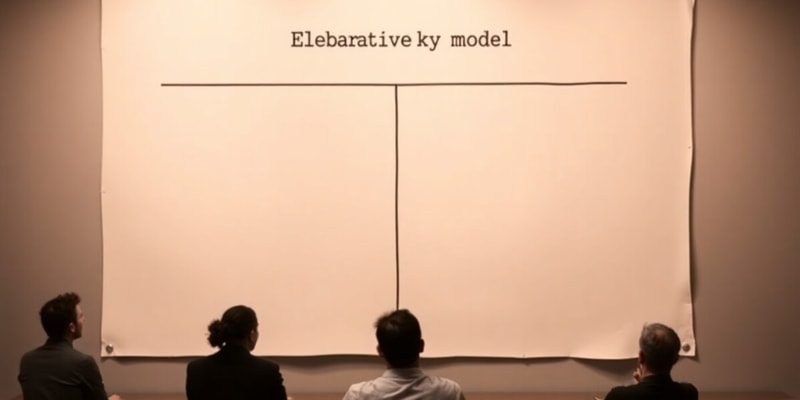Podcast
Questions and Answers
What is the primary difference between the central and peripheral routes to persuasion?
What is the primary difference between the central and peripheral routes to persuasion?
Which factor primarily determines whether an individual takes the central or peripheral route to persuasion?
Which factor primarily determines whether an individual takes the central or peripheral route to persuasion?
In a study where participants evaluated a policy based on argument strength, what led to persuasion through the central route?
In a study where participants evaluated a policy based on argument strength, what led to persuasion through the central route?
What type of attitude change is associated more with the central route of persuasion?
What type of attitude change is associated more with the central route of persuasion?
Signup and view all the answers
Which of the following best exemplifies the use of the peripheral route to persuasion?
Which of the following best exemplifies the use of the peripheral route to persuasion?
Signup and view all the answers
What aspect of persuasive messages is contrasted with the central route in the Elaboration Likelihood Model?
What aspect of persuasive messages is contrasted with the central route in the Elaboration Likelihood Model?
Signup and view all the answers
In the context of subliminal messaging, how did positive images influence evaluations of a target person?
In the context of subliminal messaging, how did positive images influence evaluations of a target person?
Signup and view all the answers
If Imelda wants to persuade her audience regarding the importance of animal shelters, what strategy should she prioritize for effectiveness?
If Imelda wants to persuade her audience regarding the importance of animal shelters, what strategy should she prioritize for effectiveness?
Signup and view all the answers
What is one way the media can influence public opinion?
What is one way the media can influence public opinion?
Signup and view all the answers
What is the 'hostile media phenomenon'?
What is the 'hostile media phenomenon'?
Signup and view all the answers
What contributes to an individual's resistance to persuasion?
What contributes to an individual's resistance to persuasion?
Signup and view all the answers
How can attitude inoculation help individuals resist persuasion?
How can attitude inoculation help individuals resist persuasion?
Signup and view all the answers
Which type of attitudes are more resistant to persuasion?
Which type of attitudes are more resistant to persuasion?
Signup and view all the answers
What is the primary effect of selective attention on individuals' attitudes?
What is the primary effect of selective attention on individuals' attitudes?
Signup and view all the answers
Which cue is commonly associated with identifying fake news?
Which cue is commonly associated with identifying fake news?
Signup and view all the answers
In the study on marijuana legalization, what did pro-legalization students focus on?
In the study on marijuana legalization, what did pro-legalization students focus on?
Signup and view all the answers
How does perceived media bias affect public opinion?
How does perceived media bias affect public opinion?
Signup and view all the answers
What phenomenon explains selective attention and evaluation of information?
What phenomenon explains selective attention and evaluation of information?
Signup and view all the answers
What was the consequence of Fox News requiring anchors to present opposing views?
What was the consequence of Fox News requiring anchors to present opposing views?
Signup and view all the answers
Why is selective attention online thought to be less widespread than previously believed?
Why is selective attention online thought to be less widespread than previously believed?
Signup and view all the answers
How do individuals typically evaluate information that contradicts their beliefs?
How do individuals typically evaluate information that contradicts their beliefs?
Signup and view all the answers
What phenomenon illustrates individuals evaluating the credibility of sources based on pre-existing beliefs?
What phenomenon illustrates individuals evaluating the credibility of sources based on pre-existing beliefs?
Signup and view all the answers
What characterizes the central route in the elaboration likelihood model of persuasion?
What characterizes the central route in the elaboration likelihood model of persuasion?
Signup and view all the answers
In the context of ideological selectivity among Twitter users, what percentage overlap was found among liberals and conservatives?
In the context of ideological selectivity among Twitter users, what percentage overlap was found among liberals and conservatives?
Signup and view all the answers
Which of the following is NOT a key element of a persuasive attempt?
Which of the following is NOT a key element of a persuasive attempt?
Signup and view all the answers
What behavior did participants in the deficiency condition exhibit when faced with a fictitious medical test?
What behavior did participants in the deficiency condition exhibit when faced with a fictitious medical test?
Signup and view all the answers
Which factor is critical in determining the effectiveness of a persuasive message?
Which factor is critical in determining the effectiveness of a persuasive message?
Signup and view all the answers
What aspect of a message can increase its persuasiveness according to audience characteristics?
What aspect of a message can increase its persuasiveness according to audience characteristics?
Signup and view all the answers
How does low motivation and ability influence the route taken in persuasion?
How does low motivation and ability influence the route taken in persuasion?
Signup and view all the answers
How does party-over-policy thinking affect individuals' support for climate policies?
How does party-over-policy thinking affect individuals' support for climate policies?
Signup and view all the answers
What factor can enhance the likelihood of persuasion in relation to the audience's mood?
What factor can enhance the likelihood of persuasion in relation to the audience's mood?
Signup and view all the answers
Which statement is true about the beliefs of Republicans regarding climate change?
Which statement is true about the beliefs of Republicans regarding climate change?
Signup and view all the answers
How does mood influence the processing of persuasive messages?
How does mood influence the processing of persuasive messages?
Signup and view all the answers
What role does age play in the susceptibility to persuasive messages?
What role does age play in the susceptibility to persuasive messages?
Signup and view all the answers
How can guilt be utilized in persuasive messages?
How can guilt be utilized in persuasive messages?
Signup and view all the answers
What is an example of political influence from the younger demographic?
What is an example of political influence from the younger demographic?
Signup and view all the answers
What misconception might participants have regarding their party's views?
What misconception might participants have regarding their party's views?
Signup and view all the answers
What is the primary function of attitude inoculation?
What is the primary function of attitude inoculation?
Signup and view all the answers
How do subliminal messages in advertising primarily influence consumers?
How do subliminal messages in advertising primarily influence consumers?
Signup and view all the answers
What is the main purpose of product placement in media content?
What is the main purpose of product placement in media content?
Signup and view all the answers
Which of the following techniques is NOT typically associated with subliminal messaging?
Which of the following techniques is NOT typically associated with subliminal messaging?
Signup and view all the answers
In Milgram's experiment, what was the significance of the incremental approach used in administering shocks?
In Milgram's experiment, what was the significance of the incremental approach used in administering shocks?
Signup and view all the answers
Which aspect of subliminal messages can enhance their effectiveness in advertisements?
Which aspect of subliminal messages can enhance their effectiveness in advertisements?
Signup and view all the answers
What technique involves securing commitment with a low initial offer before adding extra costs?
What technique involves securing commitment with a low initial offer before adding extra costs?
Signup and view all the answers
Which of the following describes a common misconception about attitude inoculation?
Which of the following describes a common misconception about attitude inoculation?
Signup and view all the answers
Which persuasion technique involves making a small request before a larger one to increase compliance?
Which persuasion technique involves making a small request before a larger one to increase compliance?
Signup and view all the answers
What role does emotional appeal play in the effectiveness of subliminal messaging?
What role does emotional appeal play in the effectiveness of subliminal messaging?
Signup and view all the answers
What is the main purpose of ingratiation as a compliance technique?
What is the main purpose of ingratiation as a compliance technique?
Signup and view all the answers
Which compliance technique creates urgency by setting a time limit on an offer?
Which compliance technique creates urgency by setting a time limit on an offer?
Signup and view all the answers
How does the Body Language Influence Persuasion Technique operate?
How does the Body Language Influence Persuasion Technique operate?
Signup and view all the answers
What is the purpose of subliminal messaging in marketing?
What is the purpose of subliminal messaging in marketing?
Signup and view all the answers
In the context of compliance techniques, what does the concept of reactance explain?
In the context of compliance techniques, what does the concept of reactance explain?
Signup and view all the answers
Which example best illustrates the low-balling technique?
Which example best illustrates the low-balling technique?
Signup and view all the answers
What is a critical factor in the effectiveness of fear-arousing communications?
What is a critical factor in the effectiveness of fear-arousing communications?
Signup and view all the answers
Which personality trait is associated with a preference for the central route of persuasion?
Which personality trait is associated with a preference for the central route of persuasion?
Signup and view all the answers
What happens when individuals are exposed to information with high personal relevance?
What happens when individuals are exposed to information with high personal relevance?
Signup and view all the answers
In the context of persuasive messages, how can motivation influence processing routes?
In the context of persuasive messages, how can motivation influence processing routes?
Signup and view all the answers
What is a common result of using the peripheral route in persuasion?
What is a common result of using the peripheral route in persuasion?
Signup and view all the answers
How does the need for cognition influence an individual's engagement with persuasive messages?
How does the need for cognition influence an individual's engagement with persuasive messages?
Signup and view all the answers
Which of the following factors can lead to reactance in persuasive situations?
Which of the following factors can lead to reactance in persuasive situations?
Signup and view all the answers
What role does personal relevance play in the central route of persuasion?
What role does personal relevance play in the central route of persuasion?
Signup and view all the answers
Study Notes
Elaboration Likelihood Model (ELM)
- Two routes to persuasion within the Elaboration Likelihood Model: central route (deliberate processing) and peripheral route (superficial processing)
- Central route: Effective for long-lasting attitude change, requires motivation and ability to process information, focuses on logical arguments and evidence
- Peripheral route: Effective for influencing less motivated audiences, relies on superficial cues like source attractiveness or number of arguments
Central Route to Persuasion
- Involves thoughtful consideration of arguments and evidence
- Leads to enduring attitude change compared to peripheral route
- Works when the audience is interested and willing to engage in deep processing
Peripheral Route to Persuasion
- Relies on superficial cues and shortcuts
- Can be effective when the audience is less motivated or attentive
- Less likely to lead to lasting attitude change compared to central route
Mood and Persuasion
- Persuasive messages are more effective when they match the audience's mood
- Pessimistic messages work better with sad people, optimistic messages resonate with happy people
- Inducing guilt can increase compliance if the message offers a way to alleviate that guilt
Persuasion and Age
- Younger people are more susceptible to persuasive messages than older people
- This age group can significantly influence political outcomes due to their malleability
Selective Attention and Exposure
- People tend to favor information that confirms their pre-existing beliefs
- Selective attention contributes to the formation of echo chambers online
- This bias can influence resistance to persuasion
Fake News and Media Bias
- Fake news exhibits characteristics like anger-inducing content, conspiracy theories, and misspellings
- Perceived media bias can contribute to partisanship and resistance to persuasion
Selective Attention and Evaluation
- Individuals selectively focus on information that supports their existing beliefs while ignoring contradicting information
- This selective evaluation can be influenced by personal motivations and existing beliefs
Dual Process Approach to Persuasion
- ELM proposes two routes to persuasion: central and peripheral
- Route selection is influenced by the individual's motivation and ability to process the message
Elements of Persuasion
- The key elements of persuasion are the source, content, and audience
- Attractive, credible, and confident sources are more persuasive
- Vivid and fear-inducing messages can be effective
- Audience characteristics like need for cognition, mood, and age affect persuasiveness
Media and Persuasion
- Media shapes opinions, tastes, and behaviors through agenda control and information dissemination
- Media can control what people think about by manipulating the number and types of news stories presented
Resistance to Persuasion
- Resistance occurs due to pre-existing biases, commitments, and knowledge
- Selective attention and evaluation reinforce original attitudes
- Public commitment to a position strengthens resistance
- Knowledgeable individuals can counter-argue opposing messages
- Attitudes based on moral principles are more resistant to persuasion
- Attitude inoculation can strengthen resistance by exposing individuals to weak arguments against their position
Attitude Inoculation
- People become more resistant to persuasion attempts by being exposed to small doses of arguments against their position.
- Similar to how exposure to a weakened virus builds immunity, exposure to opposing arguments makes a person more resistant to persuasion attempts.
- This process is crucial for building strong and resistant beliefs.
- Milgram's experiment demonstrates how gradual exposure to escalating shocks can increase compliance with more intense levels of shocks.
Subliminal Messaging
- Hidden messages embedded in advertisements to influence behavior unconsciously.
- These messages appeal to emotions or subtly suggest benefits, bypassing conscious awareness.
- Examples include:
- Derogatory images hidden in ice cubes in a Coca-Cola ad to suggest romantic benefits.
- A hidden dollar bill in a sandwich ad to reinforce its affordability.
- The word "mom" hidden in Wendy's collar to evoke a comforting feeling.
Product Placement
- Integrating branded products into media content to influence viewers' purchasing decisions.
- Subtly exposes viewers to brands, influencing their purchasing choices.
- Examples include:
- Ray-Ban sunglasses, Starbucks, Mac computers, and Doritos appearing in movies and TV shows.
Types of Compliance
- Techniques used to persuade individuals to comply with requests.
- Ingratiation: Doing favors to get something in return.
- Playing hard to get: Making oneself seem scarce or valuable.
- Deadline technique: Creating urgency by setting a time limit for a sale or offer.
Foot-in-the-Door Technique
- Initial small request increases compliance with a larger request later on.
- Creates a sense of commitment and investment in the outcome, making people more likely to agree to subsequent requests.
- For example, a neighbor asks to borrow sugar, then asks for help shopping for cake ingredients and making the cake.
Low-Balling Technique
- Initial low offer is made to secure commitment, but additional costs are added later.
- Exploits initial commitment and investment, making it harder to back out.
- For example, a vacation package advertised at a low price, but later additional costs like finder's fees are added.
Persuasion and Personal Relevance
- High personal relevance leads to central route processing: deep, logical thinking.
- Low personal relevance leads to peripheral route processing: shallow, superficial processing.
- This explains why information directly relevant to us is more likely to be carefully considered.
Need for Cognition
- A personality trait that describes individuals who enjoy engaging in effortful cognitive activities.
- High need for cognition people prefer the central route of persuasion.
- They are likely to enjoy intellectual debates and detailed information.
Fear-Arousing Communications
- Fear can be an effective persuasive tool if used moderately.
- Too much fear causes individuals to shut down and ignore the message.
- Too little fear makes the message appear insignificant.
- The most effective strategy is to induce moderate fear and provide information on how to reduce that fear.
Studying That Suits You
Use AI to generate personalized quizzes and flashcards to suit your learning preferences.
Related Documents
Description
Test your knowledge on the Elaboration Likelihood Model (ELM) and its two routes to persuasion: central and peripheral. Understand how these routes influence attitude change and the factors that affect audience motivation and engagement. Dive deep into the mechanisms of mood and persuasion.




